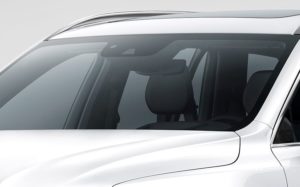
Volvo: Replace all windshields with OEM glass, approved adhesive at authorized facilities
By onAnnouncements | Education | Market Trends | Repair Operations | Technology
Volvo in a new position statement instructs collision repairers to only have windshield replacement done by an authorized Volvo location, using only OEM glass and its approved adhesive.
The OEM cited the windshield’s traditional structural role as well as the demands of newer technologies like advanced driver assistance systems and head-up displays.
“The Volvo windshield is an integral part of our vehicles,” Volvo wrote in what appears to be one of a few new position statements. “Not only does it provide for an undistorted view, it serves as a critical structural component of the vehicle.
“This is why Volvo Car USA LLC requires all windshield replacements on Volvo vehicles be performed according to Volvo standards at an authorized Volvo facility, using only Volvo Genuine Windshields and adhesives.”
Volvo said OEM-approved adhesives “will ensure proper bonding of the windshield to the vehicle’s body providing the same strength qualities as if assembled at the factory, providing a minimal safe drive-away time once installed.” It said aftermarket windshield services “may find it quite difficult to properly recalibrate” the camera and radar located behind the windshield, a task required after any new glass was installed.
Aftermarket glass itself might not be up to the “extremely stringent optical tolerances” needed for advanced driver assistance systems tied to that camera and radar, according to Volvo.
“The windshield is vital for the function of vehicles autonomous safety systems,” Volvo wrote. “Example: the ASDM (Active Safety Domain Master) is located inside the upper edge of the windshield, as such, the camera and radar in the ASDM are used in conjunction with other systems to enable the safety functions. These systems are sensitive to the optical and geometric tolerances, i.e. glass thickness and materials of the windshield. The vehicle safety systems require vehicle-specific programming which are based on several variants which demand extremely stringent optical tolerances to function as intended. Using aftermarket variants that don’t meet Volvo Car’s stringent specifications may compromise the function of said systems.”
Volvo’s head-up display takes this a step further by requiring a different glass manufacturing process altogether, according to Volvo.
“Vehicles with Multi-Dimensional Heads-Up Display are engineered to ensure clear viewing of the projected image,” Volvo wrote. “The manufacturing process for these windshields differ from a non-H.U.D. windshield. Installing the wrong windshield could result in redundant images of the projected information and overall functionality.”
More information:
Volvo “Statement on replacement of windshields”
Featured image: A 2016 Volvo XC90 with the Rugged Luxury kit is shown. (Provided by Volvo)
